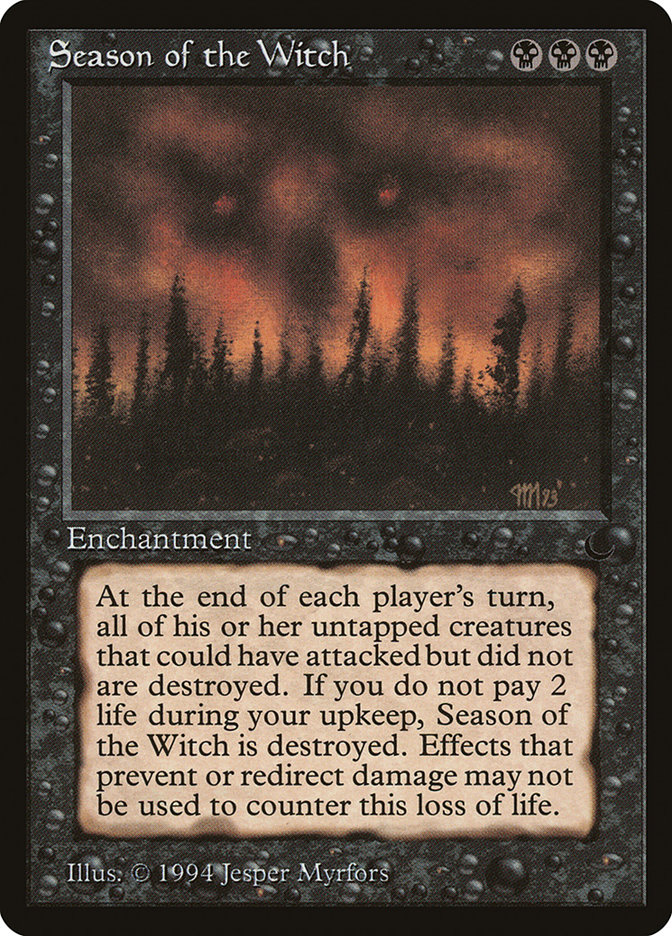Board wipes (also called “reset buttons”) are a common feature of Commander games. For our purposes they take on three forms, all named for a card which is the genesis or namesake of that effect. “Wrath Effects” destroy all creatures. “Disk Effects” destroy all (or most) non-land permanents. “World Slayers” take out land as well, although in some cases leaving some other things behind.
Board wipes are generally defensive maneuvers, although they can frequently set up offensive plays. World Slayers are frequently win conditions since they tend to leave their caster (who carefully planned them) with resources and the other players with nothing. Although bounce effects can be board wipes, especially superstars like Cyclonic Rift, we won’t cover them here since I talked about them in the first installment of this series. I will include exile effects and things which effectively wipe the board, including the large damage-dealing spells. I won’t count things like Living Death (although sometimes I’ve used it as an emergency Wrath of God) or Thieves’ Auction, because they return piles of things to the battlefield.
In Part One, we’ll cover the things that destroy or remove creatures by means other than damage. In Part Two, we’ll add the spells which deal direct damage to all (or large groups) of creatures and also the things which give large minuses to toughness. We’ll then cover the Disk Effects and World Slayers.
Wrath Effects
Named for the original creature-killer, Wrath of God, there are a few of them which unconditionally destroy all the creatures (though they might do something else as well), and some of them which do so under a condition or conditions. We’ll discuss them in the two groups. I’ll add some in the conditional group which destroy a large class or subset of creatures as well, or target a single player, significantly broadening the definition.
Strategically, the time to use a Wrath Effect is when the creature board position is either overwhelmingly against you (whether that’s a single player or the combination of other players) or when you’re facing imminent death from someone’s creatures. You can use a board wipe offensively if the conditions are right — like if you’ve already played Rootborn Defenses, can respond with Ghostway, or have Avacyn, Angel of Hope on the battlefield. You can also set up graveyard reanimation like Rise of the Dark Realms (in which case you wouldn’t want to use any graveyard hate) or Living Death (in which case you would).
Unconditional
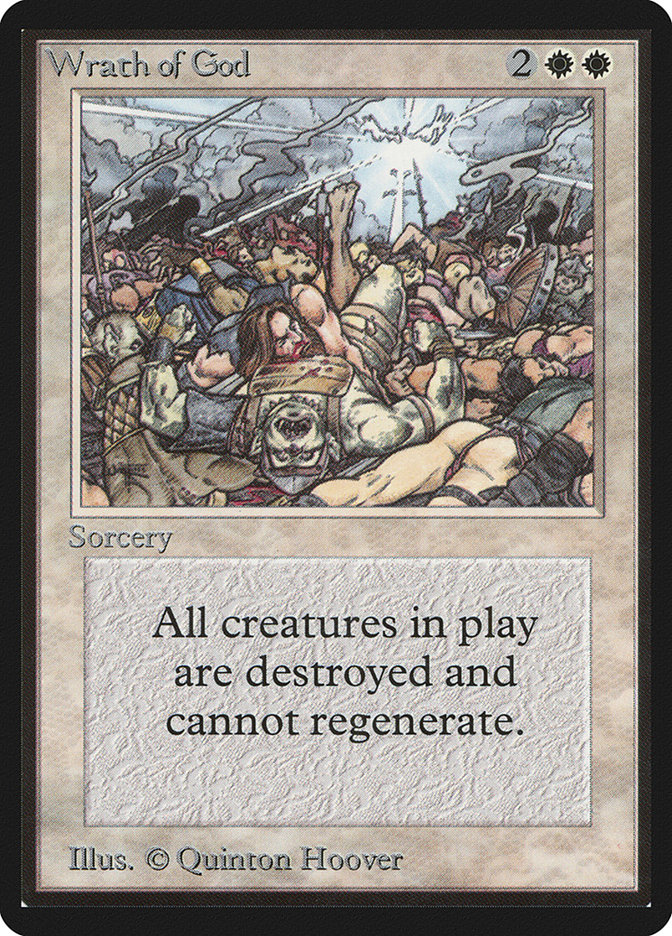 Wrath of God: Everything else is listed in alphabetical order. Wrath of God is at the top because it was the original creature killer. The “can’t be regenerated” clause makes it the king of them all.
Wrath of God: Everything else is listed in alphabetical order. Wrath of God is at the top because it was the original creature killer. The “can’t be regenerated” clause makes it the king of them all.
Austere Command: Austere Command could go into the conditional list since you choose two of the modes or it could go into the Disk Effects list because it can destroy things other than creatures. I put it here because if you choose both creature modes, you have a Wrath Effect. Note that you can regenerate.
Catastrophe: This card came out when I was living in Europe, so in my head it always has the French three syllable pronunciation instead of the English four. You can’t regenerate from this one, but unlike with modal spells, you don’t choose creatures or lands until resolution.
Damnation: The Planar Chaos version of Wrath of God gives the black and non-white (I just finished up a Logic course, so I see that in my mind’s eye as B · ~W) decks the opportunity to do the same thing.
Day of Judgment: Many people will call this “strictly worse” than Wrath of God. I’d point out to those people that you can regenerate your own creatures, too.
Decree of Pain: Too often, I’ve held onto Decree of Pain a turn or two too long, hoping to squeeze a few extra cards out of it. Learn from my lesson. Also, don’t be afraid to use the cycling ability. If someone plays Avenger of Zendikar, it can be tempting to wait so you can draw a jillion cards. Just remember that once those things are 2/3s (or bigger) Concordant Crossroads only costs G and can kill you.
Duneblast: This has been in my Karador deck since the card came out, and I don’t think I’ve yet gotten to play it. Karador is the obvious choice to keep around there. In other decks, your giant monster who can now attack into an empty field is the right call.
End Hostilities: You can regenerate from this. It is probably worth the extra mana (over Day of Judgment) in order to catch some equipment as well.
Fated Retribution: Board wipes as instants are strong, very strong. If you have the mana and want to cast a creature spell of your own, playing it on your turn is the obvious choice. You could always be techy and cast it with your creature spell on the stack, since it will resolve first and you can still scry.
Final Judgment: Well worth the two extra mana because exile is way stronger in the format than destruction because people love to reuse and abuse their graveyards. Don’t let them.
Hallowed Burial: Let the tuck debate rage again. Meanwhile, continue playing Hallowed Burial and its taller, better-looking brother, Terminus.
In Garruk’s Wake: Yeah, okay, this could go on the conditional list, but I think you’re fine with this being up here.
Kirtar’s Wrath: This was big in the earlier days of the format when we simply had fewer Wrath Effects. Now, the 2 tokens seem kind of quaint. For one more mana, Martial Coup will get you 7 tokens. I still play it in a few decks, especially in the Do Over Project, in which I have fewer choices than building a deck completely from scratch.
Life’s Finale: You’re not fooling anyone when you play this and put awesome things in someone’s graveyard. You’re playing black. We know you’re going to try to reanimate them (unless your plan is to then drop Bojuka Bog).
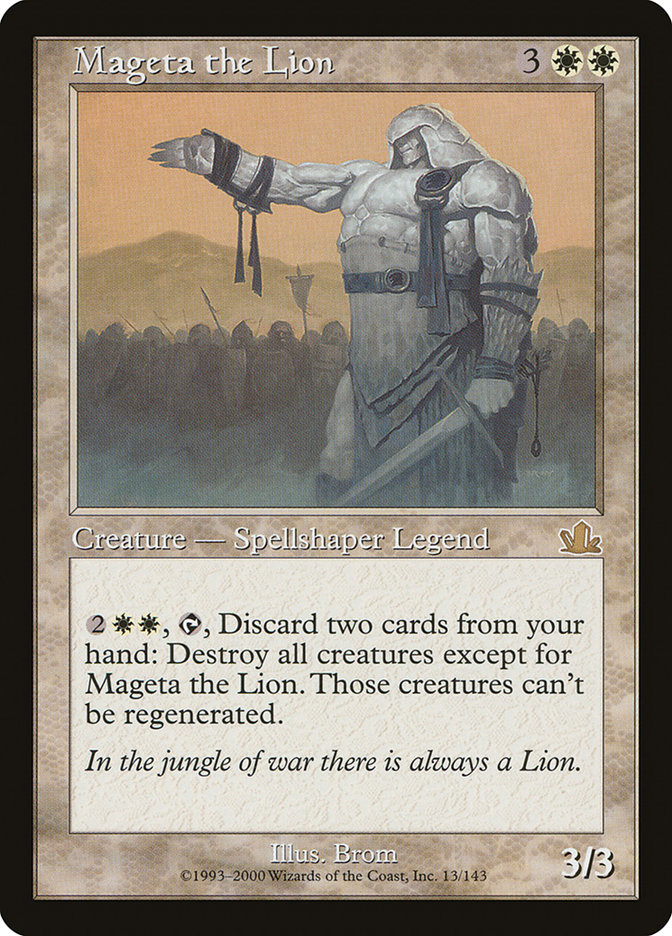 Mageta the Lion: This was a moderately popular General back in the ancient days, even though white doesn’t have that much reanimation. It would still seem to have value as 1 of 99 in a W/B/x deck. I can’t help but think about Karador again.
Mageta the Lion: This was a moderately popular General back in the ancient days, even though white doesn’t have that much reanimation. It would still seem to have value as 1 of 99 in a W/B/x deck. I can’t help but think about Karador again.
March of Souls: Obviously, it’s worth exchanging seriously good creatures for 1/1s, even if they have flying, but there are simply better options available at (effectively) this cost in the format — unless you have some kind of plan (like being able to kill everyone else’s flyers) or Engineered Plague set to Spirit.
Merciless Eviction: Choices are nice. I don’t think I’ve ever seen anyone choose planeswalkers. The colors of Merciless Eviction have copious sacrifice outlets (especially black), so you don’t much need worry about exiling your own creatures if you use that mode.
Mogg Infestation: This one is unfortunately targeted to a single player. It might be the “friendliest” of all of them because it leaves them at least with something — two 1/1 Goblins for each creature destroyed. Of course, it has the great offensive use of doubling the number of Goblins you have if you want to target yourself.
Myojin of Cleansing Fire: Wrath Effects have instances provide you with a great deal of flexibility. You can wait until the end of turn of the player to your right, which will make you the first one out of the gate to recover (and you’ll still have the Myojin). Of course, the best way to get mileage out of the Myojin is to play some cards with Proliferate and always keep counters on it. That way, you get the double whammy of being able to keep it indestructible and keep its ability available at all times.
Necromantic Selection: Sure, you can only use this once (without fetching it from exile with Riftsweeper), but the ability to reanimate the best creature on the board—not just your own, but anyone’s — leads to situations like plucking someone’s Sepulchral Primordial and starting a chain which gives you so much more than one creature. With Clones and Karmic Guides in other players’ graveyards, I’ve seen the Primordial of the Black, as we call it locally, reanimate nearly the entirety of all graveyards.
Phyrexian Rebirth: When the Wrath Effect is a survival technique, you don’t care what extra bonus you get. When the extra bonus is a giant monster, it turns you from the defensive player to the aggressive one right away.
Plague Wind: It’s expensive, and worth every bit of it. It might set up an Archenemy-like situation, but what do you care? You have all your creatures and everyone else has nothing.
Rout: The ability to pay two extra mana in order to cast a spell as an instant is design space I would have expected them to explore a little more over the years. Again, it’s flexibility. If someone creates a swarm of creatures and then suddenly gives them haste (like with Concordant Crossroads), you have an answer.
Sunscour: I played this way back when, before more mana-friendly things like Day of Judgment were available.
Supreme Verdict: While it can’t be countered, the creatures can be regenerated, which creates an argument as to whether or not it’s better than Wrath of God.
Terminus: Sometimes you have to deal with indestructible creatures. And sometimes you need a miracle.
Conditional
Aether Snap: Tokens are a major part of the format. You’ll see decks, like Ghave, Guru of Spores or Rith, the Awakener, that run few non-token creatures. Avenger of Zendikar is a major player in creating immense and deadly armies. Being a sorcery, you’ll have to pick your spots, but it’s a card I continually mention that folks may want to consider playing more of.
Angel of the Dire Hour: The subset here is smaller than with most other cards we’ve listed. You nonetheless have a pretty good shot at wiping the entirety of someone’s board (perhaps someone trying to kill you). A techy play is to let the creatures deal combat damage (to someone else, obviously) and then flash in the Angel during the end of combat steps — the creatures are still attacking until the phase ends. Might be one of the better two-for-ones you get.
Breaking Point: Listed for completeness, I doubt we see much of it in play. It’s most likely, given the higher life totals in the format, that the person who has most to lose will simply pay six life.
Cleanse: At one point, this card commanded a high dollar value because it took care of the Necro Summer creatures. As Legends cards go, it’s not particularly expensive. Combine with another Legends card, Touch of Darkness, to get a much cheaper Plague Wind.
Consume the Meek: As with Aether Snap, this is predominantly a token-killer. This one is an instant, and by my count, far more valuable and capable of saving your life right now.
Crux of Fate: I would GG anyone who played this against my Karrthus deck. It’s the kind of card which I think Richard Garfield imagined would have impact on groups — one player starts dominating with his Dragons, one of his friends goes out and finds the Dragon answer.
Culling Sun: Another token-killer which will leave your giant creatures alive, we don’t see too much of it in the format. At only one more mana, Austere Command’s greater flexibility leads it to being a more prevalent choice.
Do or Die: A cheap way of getting rid of a good portion of someone’s board. I love the gamesmanship of creating the piles. Note that you can target yourself. This might be relevant if you have Grave Pact or Dictate of Erebos on the battlefield and can create an even more awkward situation for your opponents.
Deathbringer Regent: There are three different conditions on this one: you have to have cast it from your hand, there have to be five creatures or more other creatures on the battlefield when it triggers, and there have to be five or more creatures when the trigger resolves. It’s narrow, but it’s a Dragon.
Desolation Giant: Be careful with this once-superstar of the format (back when there wasn’t so much mass reanimation around). If someone brings this back for you, you won’t have the opportunity to pay the kicker (it is even worse with Desolation Angel).
Dread Cacodemon: Another conditional trigger, this is probably only of value if you’ve already attacked or have a way of untapping your team. Maybe Intruder Alarm?
Elspeth, Sun’s Champion: Unlike the token-murderers we’ve mentioned, Elspeth takes care of the larger creatures. And creates small ones.
Endemic Plague: A very narrow card which I don’t expect will ever see much play, I suppose it could be a complete Wrath Effect if you sacrifice a creature with Changeling, like Cairn Wanderer. No regeneration possible here.
Extinction: There was a time when I packed this card in black decks just for Slivers. There are so many great tribal decks out there right now, you’re likely to always have good choices.
Extinguish All Hope: A slightly more expensive black Wrath Effect, I’m not sure it does that much more since the enchantment creatures you’re likely playing are Gods and therefore indestructible. I suppose Nighthowler is in the color, and there are the Archetypes which see a fair amount of play.
False Prophet: This one exiles as opposed to destroying, leading his flock into the eternal abyss. Whether you use it as a rattlesnake or with a sacrifice outlet, it will do some heavy lifting.
Fell the Mighty: Outstanding flexibility and choice from this one. The major downside is that it’s targeted; someone can ruin your plans by killing or making the target invalid.
Fight to the Death: Suicide a bunch of small creatures into some monsters. Wipe out everyone.
Forced March: This has actually seen some play locally by Armada regular Chris Kruse. Seems a little expensive, but it can be another inexpensive token killer.
Guan Yu’s 1,000-Li March: Sunblast Angel before there was Sunblast Angel. I might to pick up one of these for my Obzedat deck. Or anything also playing Opposition.
Harsh Mercy: Only valuable in environments which don’t have lots of tribal decks. Certainly worthwhile if you’re playing tribal and no one else is. They get to keep one creature, but you get to keep all or most of yours.
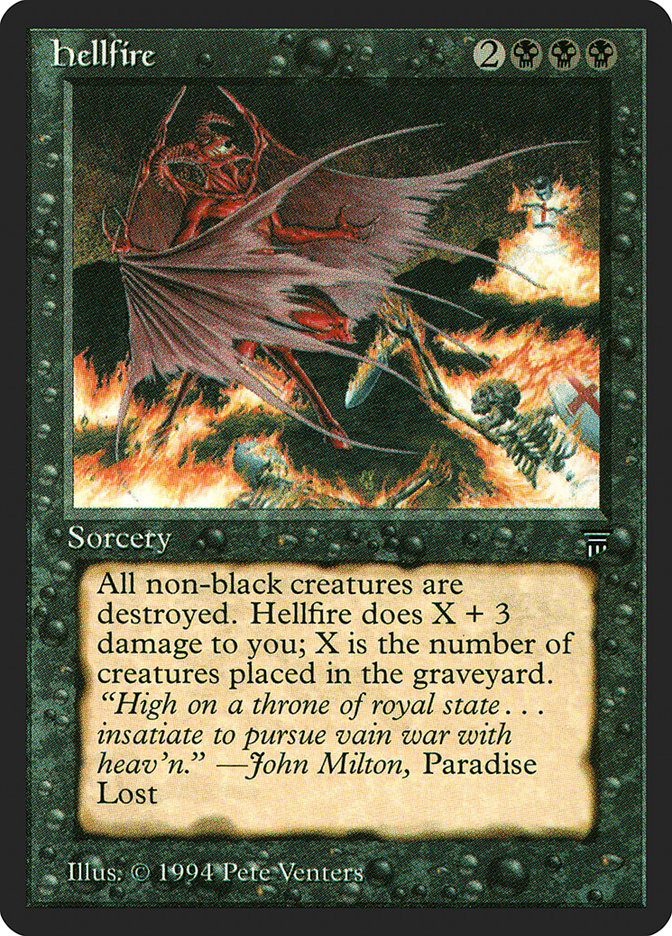 Hellfire: Just what the doctor ordered for some black decks. It’s easy to misread the card and think you have to take three for each creature that died. It’s actually one for each creature, then three on top of that — a small price to pay for a controlled Wrath Effect.
Hellfire: Just what the doctor ordered for some black decks. It’s easy to misread the card and think you have to take three for each creature that died. It’s actually one for each creature, then three on top of that — a small price to pay for a controlled Wrath Effect.
Hour of Reckoning: I suppose you could play it as an extra Wrath in a non-token deck, but unless you’re a completist, there’s no reason to. If you’re playing tokens, now things are different.
Hythonia the Cruel: Gorgons really isn’t much of a tribe. This will hit nearly everything (that’s not a Changeling).
Magister of Worth: Will of the Council is one of the coolest mechanics to come along in a while. The direction this one goes will generally be clear from before the first vote, given the particularities of the board state.
Martial Coup: I’m reasonably sure I’ve never seen it played for less than five. Nice way to have a Wrath Effect and start over at the same time.
Mass Calcify: A little too mana-intensive to play in nonwhite decks, and you’re never sure what you’re going to catch.
Major Teroh: Black is the color of reanimation. Exiling all black creatures makes this doubly strong. This won’t get the whole board, but it will get a significant portion of it, including the multicolor creatures with black in them (like Lord of Extinction).
Martyr’s Cry: The only real way I see this as valuable is to create a bunch of white tokens first, then draw a pile of cards for WW.
Nature’s Ruin: I am a fan. Green is the best color in the format. The tough part about killing all the green creatures is that you want to have some too.
Necroplasm: All you need to do is be tricky and never let it have three counters on it at the beginning of your end step. You could use Proliferate or similar trickery.
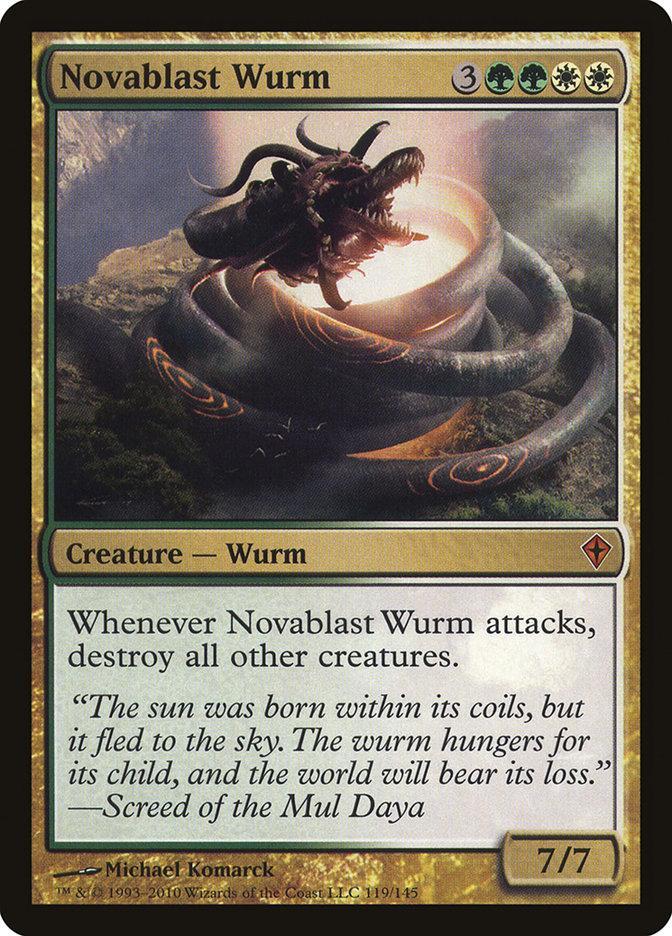 Novablast Wurm: This got a little play when it was new, but it seems like it’s the kind of thing control-ish decks might really want to play. Repeatable, zero-cost Wrath Effects are a game changer.
Novablast Wurm: This got a little play when it was new, but it seems like it’s the kind of thing control-ish decks might really want to play. Repeatable, zero-cost Wrath Effects are a game changer.
Reiver Demon: Remember that you can Clone someone else’s Reiver Demon. If you cast the Clone from your hand, the ability will trigger.
Overwhelming Forces: Yes, it’s the same cost as Decree of Pain and will draw you fewer cards. It will also keep your creatures alive. There is generally imbalance in the creature count of your opponents anyway, so you just take care of the stronger one. Maybe it buys you a little political capital while you’re refilling your hand.
Perish: Better than Nature’s Ruin because they cause the same and you can’t regenerate from Perish. It’s a card I love to pack in Grixis decks.
Planar Collapse: The upside is the low mana cost. The downside is everyone sees it coming.
Puppet’s Verdict: For you chaos players, here’s an auto-include.
Rain of Daggers: Maybe if you’re also playing Repay in Kind?
Reign of Terror: See Rain of Daggers.
Retaliate: The downside is that you have to take damage. The upside is that it’s a complete surprise and can be a horrible blowout.
Retribution of the Meek: One less than Wrath of God, also can’t be regenerated, hits most of what’s on the board anyway. My only regret is not being able to get it in foil.
Righteous Fury: Portal had it in for tapped creatures! I really need to start playing this one, once again probably in an Opposition deck.
Season of the Witch: Cards were weirder back in The Dark. I guarantee you’ll read this again the first half dozen times you play it. Assuming you play it.
Siren’s Call: Summoning Sickness creatures are ignored, but those that didn’t attack because they couldn’t, like because of Moat or Teferi’s Moat or Dueling Grounds, they’re out of luck.
Solar Tide: The Entwine cost is a little steep, which is why we’re unlikely to see much of the card.
Spreading Plague: We see this one locally every now and again, and it’s always crazy. Playing it with indestructible creatures is a fine idea, as is playing it with colorless ones.
Sunblast Angel: Lesson from experience I’ll share with you: don’t play this with Lurking Predators, at least if you plan on attacking. I have absolutely wrecked myself at least a couple of times.
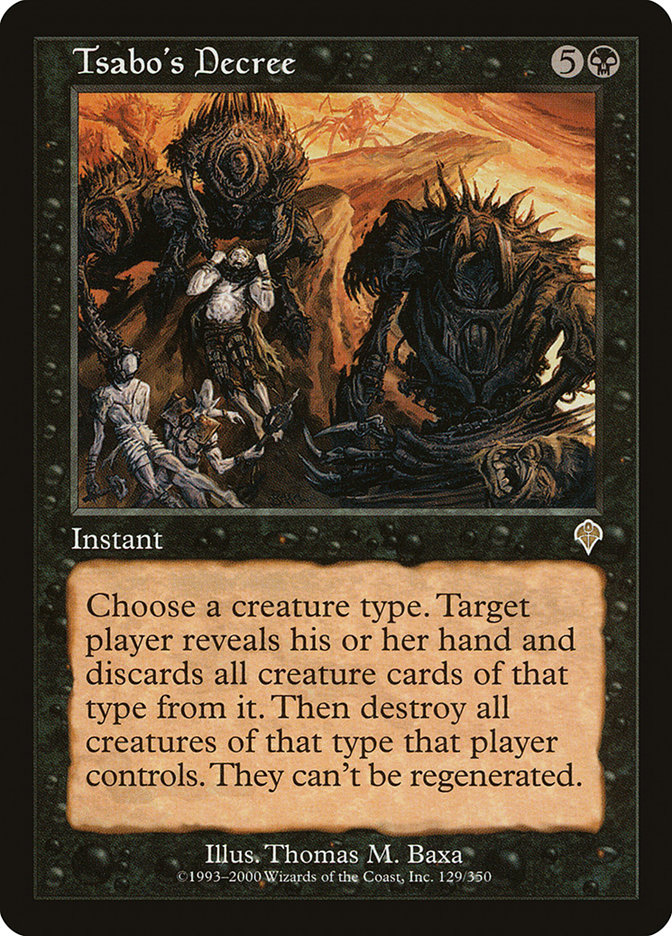 Tsabo’s Decree: This is another one which started out as a Sliver-killer and moved on to greater flexibility. The ability to hit the hand as well, which you don’t see much in instants, rounds out the card nicely.
Tsabo’s Decree: This is another one which started out as a Sliver-killer and moved on to greater flexibility. The ability to hit the hand as well, which you don’t see much in instants, rounds out the card nicely.
Virtue’s Ruin: Love the art, stoked that it’s finally available in foil. Not quite as good as Perish, since they can regenerate (and there are probably fewer white creatures running around).
Wave of Terror: At the mana you’ll invest over several turns, you might have better choices. It also might prevent or delay players from playing certain things because they don’t want them to get nuked. It’s not something I’d play without an additional part of the plan.
Whirlwind: Many of the scariest creatures in the format fly. Why not knock them all out of the air?
Winds of Rath: An alt-Wrath that you don’t really need to work that hard to use to your own benefit. Creature enchantments are orders of magnitude better than they used to be (like when this card came out), but still aren’t something we see all that much of (mostly because of Equipment).
Broadening the definition of what a Wrath Effect can be offers you a broad selection of cards to fit your particular deck, environment, or play style’s need. The majority of things we saw on the Wrath Effect list are white or black. When we get to Part Two and cover damage, you won’t be surprised to find red stepping forward.
This Week’s Deck Without Comment is my Wrath-happiest deck, Obzedat.
Creatures (30)
- 1 Avatar of Woe
- 1 Solemn Simulacrum
- 1 Kokusho, the Evening Star
- 1 Withered Wretch
- 1 Bottle Gnomes
- 1 Undead Gladiator
- 1 Bane of the Living
- 1 Duplicant
- 1 Havoc Demon
- 1 Marble Titan
- 1 False Prophet
- 1 Kagemaro, First to Suffer
- 1 Loxodon Gatekeeper
- 1 Ghost Council of Orzhova
- 1 Orzhov Pontiff
- 1 Magus of the Tabernacle
- 1 Necrotic Sliver
- 1 Stonecloaker
- 1 Deathbringer Liege
- 1 Kalitas, Bloodchief of Ghet
- 1 Nirkana Revenant
- 1 Sun Titan
- 1 Elesh Norn, Grand Cenobite
- 1 Suture Priest
- 1 Treasury Thrull
- 1 Obzedat, Ghost Council
- 1 Crypt Ghast
- 1 Thrull Parasite
- 1 Hythonia the Cruel
- 1 Agent of Erebos
Lands (37)
- 1 Cabal Coffers
- 7 Plains
- 1 Volrath's Stronghold
- 13 Swamp
- 1 Scrubland
- 1 Shizo, Death's Storehouse
- 1 Tainted Field
- 1 Temple of the False God
- 1 Maze of Ith
- 1 High Market
- 1 Godless Shrine
- 1 Orzhov Basilica
- 1 Orzhova, the Church of Deals
- 1 Terramorphic Expanse
- 1 Bojuka Bog
- 1 Evolving Wilds
- 1 Command Tower
- 1 Isolated Chapel
- 1 Vault of the Archangel
Spells (33)
- 1 Nevinyrral's Disk
- 1 Land Tax
- 1 Sol Ring
- 1 Meekstone
- 1 Fellwar Stone
- 1 Ambition's Cost
- 1 Gilded Lotus
- 1 Crackdown
- 1 Planar Collapse
- 1 Rout
- 1 Tormod's Crypt
- 1 Debtors' Knell
- 1 Leyline of the Void
- 1 Orzhov Signet
- 1 Sudden Spoiling
- 1 Armillary Sphere
- 1 Black Sun's Zenith
- 1 Gruesome Encore
- 1 White Sun's Zenith
- 1 Pristine Talisman
- 1 Praetor's Grasp
- 1 Mycosynth Wellspring
- 1 Martyr's Bond
- 1 Staff of Nin
- 1 Blind Obedience
- 1 Merciless Eviction
- 1 Obzedat's Aid
- 1 Fated Retribution
- 1 Coercive Portal
- 1 Perilous Vault
- 1 End Hostilities
- 1 Necromantic Selection
- 1 Infinite Obliteration

Check out our awesome Deck List Database for the last versions of all my decks:
ADUN’S TOOLBOX;
ANIMAR’S SWARM;
AURELIA GOES TO WAR;
CHILDREN of a LESSER GOD;
DEMONS OF KAALIA;
EREBOS and the HALLS OF THE DEAD;
GLISSA, GLISSA;
HELIOD, GOD OF ENCHANTMENTS;
DREAMING OF INTET;
FORGE OF PURPHOROS;
KARN, BEATDOWN GOLEM;
HALLOWEEN WITH KARADOR;
KARRTHUS, WHO RAINS FIRE FROM THE SKY;
KRESH INTO THE RED ZONE;
LAVINIA BLINKS;
LAZAV, SHAPESHIFTING MASTERMIND;
ZOMBIES OF TRESSERHORN;
MELEK’S MOLTEN MIND GRIND;
MERIEKE’S ESPER CONTROL;
THE MILL-MEOPLASM;
MIMEOPLASM DO-OVER;
NATH of the VALUE LEAF;
NYLEA OF THE WOODLAND REALM;
OBZEDAT, GHOST KILLER;
PURPLE HIPPOS and MARO SORCERERS;
ZEGANA and a DICE BAG;
RITH’S TOKENS;
YOU DID THIS TO YOURSELF;
RURIC THAR AND HIS BEASTLY FIGHT CLUB;
THASSA, GOD OF MERFOLK;
THE ALTAR of THRAXIMUNDAR;
TROSTANI and HER ANGELS;
THE THREAT OF YASOVA;
RUHAN DO-OVER;
KARADOR DO-OVER;
KARRTHUS DO-OVER
If you’d like to follow the adventures of my Monday Night RPG group (in a campaign that’s been alive since 1987 and is just now getting started with a new saga called “The Lost Cities of Nevinor”), ask for an invitation to the Facebook group “Sheldon Menery Monday Night Gamers.”


